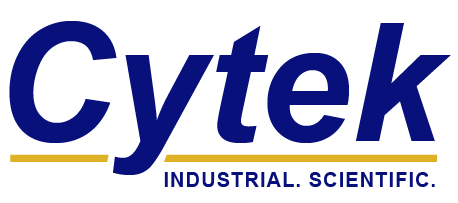
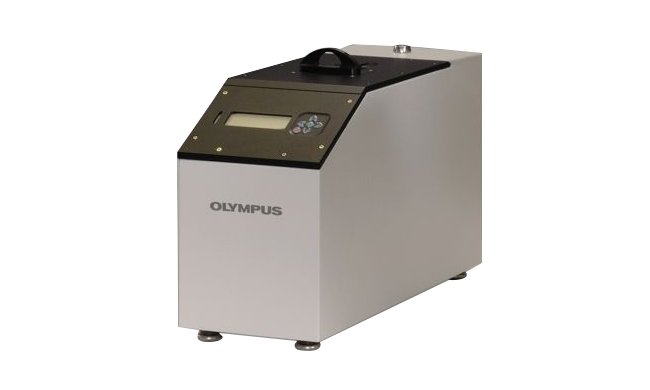
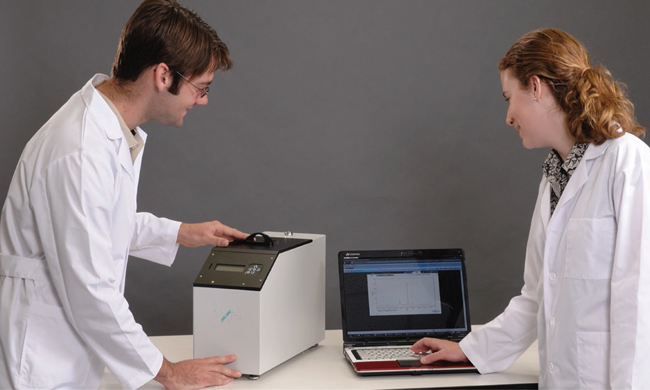
The BTX II Benchtop X-ray Diffraction/X-ray Fluorescence is, simply put, the first combined XRD/XRF instrument designed with ease of use in mind. From educational settings, to the rigors of a QC application, BTX II is well suited. Based on the filled proven reliable design of TERRA, our field portable XRD/XRF instrument, BTX II features the same level of performance, but without the aspects of a portable instrument. The technology used in the portable rock and mineral analyzer received a prestigious R&D 100 award and was chosen to fly on the Mars Science Laboratory Rover scheduled for launch in 2011. Check out the NASA site for more.
The BTX II is a compact combination XRF/XRD system designed for powder analysis. Now XRD work can really be done in an easy to use, small footprint, low cost configuration. With the BTX II patented sample handling system, not only is sample preparation time minimized, but accuracy in peak identification previously only available using large and expensive laboratory based systems can now be achieved.
 BTX II 's unique direct excitation CCD camera provides performance previously found only with lab based XRF/XRD instruments
BTX II 's unique direct excitation CCD camera provides performance previously found only with lab based XRF/XRD instruments
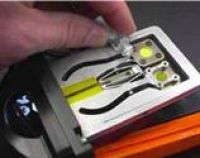 Loading The Vibrating Sample Holder
Loading The Vibrating Sample Holder
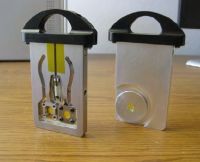 Sample Holders
Sample Holders
BTX II is shipped with the necessary software (XPowder) for processing the resulting X-ray diffraction data. This includes the AMCSD mineral database.
For quantitative analysis, XPowder comes complete with reference intensity ratio (RIR) quantitative analysis methods as well as full-pattern analysis tools.
Furthermore, BTX II provides XRD pattern data in a variety of file formats, making XRD pattern interpretation in third-party programs easily accessible.
X-ray Diffraction Data

Search/Match & XRD Quantitative Analysis Software Included
X-ray Fluorescence Data

Qualitative XRF Scan

BTX II operates off software embedded in the unit itself. The user accesses the operating system through a wireless connection (802.11b/g). This remote operation method allows for a wide degree of flexibility in controlling the instrument and subsequent data handling.
| XRD resolution | 0.25o 2Ø FWHM |
|---|---|
| XRD range | 5 - 55o 2Ø |
| Detector type | 1024 x 256 pixels; 2D Peltier-cooled CCD |
| XRF energy resolution | 200eV at 5.9 keV |
| XRF energy range | 3 to 25 keV |
| Sample grain size | <150µm crushed minerals (100 mesh screen, 150µm) |
| Sample quantity | ~ 15 mg |
| X-ray target material | Co or Cu (Co standard) |
| X-ray tube voltage | 30 kV |
| X-ray tube power | 10W |
| Data storage | 40 Gb- Ruggedized inteal hard drive |
| Wireless connectivity | 802.11 b/g for remote control from web browser |
| Operating temperature | -10oC to 35oC |
| Weight | 12.5 kg |
| Size | 11.75 x 6.9 x 19.5 in (30 x 17 x 47 cm) |
| Power requirements | Simple AC power (no cooling systems) |
The BTX II operates off software embedded in the unit itself. The user accesses the operating system through a wireless connection (802.11 b/g). This unique method of operation allows for a wide degree of flexibility in controlling the instrument and subsequent data handling.
If you have question you can reach us. Just fill up the form below.